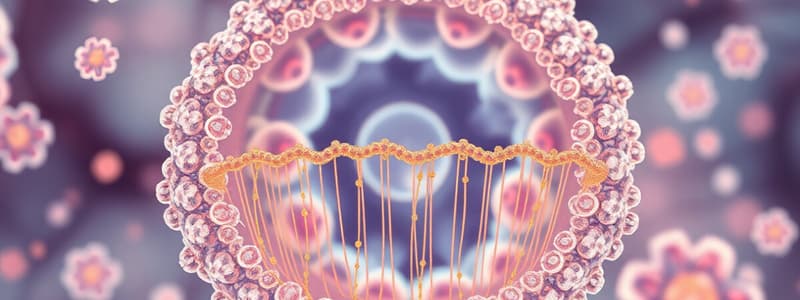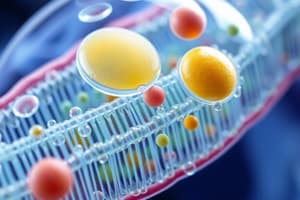Podcast
Questions and Answers
What is the primary function of exocytosis?
What is the primary function of exocytosis?
- To fuse with lysosomes
- To form vesicles
- To take in nutrients
- To export products from the cell (correct)
Phagocytosis is known as 'cellular drinking.'
Phagocytosis is known as 'cellular drinking.'
False (B)
What is required for bulk transport processes, such as exocytosis and endocytosis?
What is required for bulk transport processes, such as exocytosis and endocytosis?
Energy
In receptor-mediated endocytosis, the binding of _____ to receptors triggers vesicle formation.
In receptor-mediated endocytosis, the binding of _____ to receptors triggers vesicle formation.
Match the type of transport with its description:
Match the type of transport with its description:
What is the primary composition of the cell membrane?
What is the primary composition of the cell membrane?
The plasma membrane is 8 nm thick.
The plasma membrane is 8 nm thick.
What characteristic describes the arrangement of phospholipids in the cell membrane?
What characteristic describes the arrangement of phospholipids in the cell membrane?
The fluid mosaic model describes the membrane as being a _________ structure.
The fluid mosaic model describes the membrane as being a _________ structure.
Match the following features of the cell membrane with their descriptions:
Match the following features of the cell membrane with their descriptions:
Which part of the membrane proteins is oriented towards the cytosol?
Which part of the membrane proteins is oriented towards the cytosol?
It is common for molecules to easily flip-flop between the layers of the phospholipid bilayer.
It is common for molecules to easily flip-flop between the layers of the phospholipid bilayer.
What model explains the structure of the plasma membrane?
What model explains the structure of the plasma membrane?
What type of molecules can pass through the cell membrane rapidly?
What type of molecules can pass through the cell membrane rapidly?
Polar molecules can cross the plasma membrane easily.
Polar molecules can cross the plasma membrane easily.
What is the role of transport proteins in the cell membrane?
What is the role of transport proteins in the cell membrane?
A __________ protein has a hydrophilic channel that allows certain molecules or ions to pass through the membrane.
A __________ protein has a hydrophilic channel that allows certain molecules or ions to pass through the membrane.
Which of the following describes passive transport?
Which of the following describes passive transport?
Dynamic equilibrium occurs when molecules no longer cross the membrane.
Dynamic equilibrium occurs when molecules no longer cross the membrane.
What term describes the movement of molecules from an area of high concentration to an area of low concentration?
What term describes the movement of molecules from an area of high concentration to an area of low concentration?
Substances diffuse down their __________ gradient.
Substances diffuse down their __________ gradient.
Match the following types of transport proteins with their descriptions:
Match the following types of transport proteins with their descriptions:
Carrier proteins transport substances without changing shape.
Carrier proteins transport substances without changing shape.
What is the process of osmosis?
What is the process of osmosis?
Isotonic solutions cause cells to gain or lose water?
Isotonic solutions cause cells to gain or lose water?
Define tonicity in the context of cellular environments.
Define tonicity in the context of cellular environments.
A solution with a lower solute concentration compared to the cell is termed a ______ solution.
A solution with a lower solute concentration compared to the cell is termed a ______ solution.
Match the following types of solutions with their effects on red blood cells:
Match the following types of solutions with their effects on red blood cells:
What role do transport proteins play in facilitated diffusion?
What role do transport proteins play in facilitated diffusion?
Water moves from an area of high solute concentration to low solute concentration during osmosis.
Water moves from an area of high solute concentration to low solute concentration during osmosis.
What is the primary role of glycoproteins in cell membranes?
What is the primary role of glycoproteins in cell membranes?
Intercellular joining is typically short-lived compared to cell-cell recognition.
Intercellular joining is typically short-lived compared to cell-cell recognition.
What happens to a cell in a hypertonic solution?
What happens to a cell in a hypertonic solution?
What is the function of integrins in a cell membrane?
What is the function of integrins in a cell membrane?
In facilitated diffusion, molecules move across the plasma membrane with the help of ______ proteins.
In facilitated diffusion, molecules move across the plasma membrane with the help of ______ proteins.
Cells recognize each other by binding to surface molecules, often ________ on the plasma membrane.
Cells recognize each other by binding to surface molecules, often ________ on the plasma membrane.
Match the following solutions with their concentration relationships:
Match the following solutions with their concentration relationships:
What type of junctions do membrane proteins of adjacent cells form for intercellular joining?
What type of junctions do membrane proteins of adjacent cells form for intercellular joining?
Membrane carbohydrates are always covalently bonded to proteins.
Membrane carbohydrates are always covalently bonded to proteins.
Name one major function of membrane proteins.
Name one major function of membrane proteins.
The external messenger interacting with a protein typically leads to a change in ________ of the protein.
The external messenger interacting with a protein typically leads to a change in ________ of the protein.
Match the following membrane protein functions with their descriptions:
Match the following membrane protein functions with their descriptions:
Which of the following describes a function of membrane carbohydrates?
Which of the following describes a function of membrane carbohydrates?
Study Notes
Cell Membrane Structure & Function
- The plasma membrane is the outer boundary of a cell, separating it from its surroundings.
- It's selectively permeable, allowing certain substances to cross more easily than others.
- Lipids and proteins are the primary components of membranes, with carbohydrates also playing a role.
- Phospholipids, the most abundant lipids, have a hydrophilic head and a hydrophobic tail, forming a bilayer.
- Membrane proteins are embedded in the phospholipid bilayer, with their hydrophilic regions exposed to the aqueous environment.
- The fluid mosaic model describes the membrane as a fluid structure with embedded protein molecules.
Membrane Fluidity
- Membranes aren't rigid structures; they're held together by weak hydrophobic interactions.
- Lipids and some proteins can move laterally within the membrane.
- Transverse movement (flip-flopping) across the bilayer is less common.
Functions of Membrane Proteins
- Cell-cell recognition: Glycoproteins act as identification tags for cell-cell interactions.
- Intercellular joining: Membrane proteins from adjacent cells form junctions like gap junctions and tight junctions.
- Attachment to cytoskeleton and extracellular matrix (ECM): Proteins connect to cytoskeleton and ECM, contributing to cell shape and stability.
- Transport: Carrier and channel proteins facilitate the movement of molecules across the membrane.
- Enzymatic activity: Proteins can act as enzymes, catalyzing reactions within the membrane.
- Signal transduction: Membrane proteins can receive signals from the environment and relay them to the cell's interior.
Membrane Carbohydrates in Cell-Cell Recognition
- Carbohydrates are often covalently bonded to lipids (glycolipids) or proteins (glycoproteins) on the cell surface.
- These sugar variations on the external membrane contribute to cell-cell recognition, explaining differences between species, individuals, and cell types.
Permeability of the Lipid Bilayer
- Hydrophobic (nonpolar) molecules can easily cross the lipid bilayer, while polar molecules struggle.
- Transport proteins provide passage for hydrophilic substances.
Transport Proteins
- Channel proteins: Create hydrophilic channels for specific molecules or ions to pass through. Aquaporins are a type of channel protein for water.
- Carrier proteins: Bind to molecules, change shape, and shuttle them across the membrane.
Passive Transport
- Diffusion: The tendency for molecules to move from areas of high concentration to areas of low concentration, driven by a concentration gradient.
- Osmosis: The diffusion of water across a selectively permeable membrane, moving from regions of lower solute concentration to regions of higher solute concentration.
Tonicity
- Isotonic solution: Solute concentration is equal inside and outside the cell, resulting in no net water movement.
- Hypertonic solution: Higher solute concentration outside the cell, causing water to leave the cell.
- Hypotonic solution: Lower solute concentration outside the cell, causing water to enter the cell.
Facilitated Diffusion
- Type of passive transport where proteins help move molecules across the membrane down the concentration gradient.
Bulk Transport
- Requires energy to move large molecules or particles across the membrane.
Exocytosis
- The cell releases contents from vesicles by fusing them with the plasma membrane.
- Many secretory cells use this to export products.
Endocytosis
- The cell takes in macromolecules by forming vesicles from the plasma membrane.
- Three types:
- Phagocytosis: “Cellular eating,” engulfing large particles.
- Pinocytosis: “Cellular drinking,” engulfing extracellular fluid.
- Receptor-mediated endocytosis: Specific ligands bind to receptors, triggering vesicle formation.
Studying That Suits You
Use AI to generate personalized quizzes and flashcards to suit your learning preferences.
Related Documents
Description
Test your knowledge on the structure and function of cell membranes. This quiz covers topics like the fluid mosaic model, membrane fluidity, and the roles of lipids and proteins. Perfect for biology students studying cell biology concepts.




